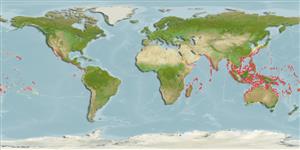Common names from other countries
Environment: milieu / climate zone / depth range / distribution range
Οικολογία
; εύρος βάθους 62 - 64 m (Ref. 101029). Tropical
Indo-Pacific.
Length at first maturity / Μέγεθος / Βάρος / Age
Maturity: Lm ? range ? - ? cm Max length : 10.0 cm ShH αρσενικό/απροσδιόριστο; (Ref. 349); common length : 8.5 cm SHL αρσενικό/απροσδιόριστο; (Ref. 349)
Length based on occurrence record; to be replaced with better reference. Lives in shallow waters near coral reefs (Ref. 799). Lower intertidal fringe and sublittoral to shelf zones (Ref. 349). Feeds on small crabs (Ref. 85382).
Life cycle and mating behavior
Γεννητική Ωρίμανση | Αναπαραγωγή | Γεννοβολία | Αβγά | Γονιμότητα | Προνύμφες
This species is a non-broadcast spawner. Life cycle does not include trocophore stage. Also Ref. 833.
Poutiers, J.M. 1998. (Ref. 349)
IUCN Red List Status (Ref. 130435)
CITES status (Ref. 108899)
Not Evaluated
Not Evaluated
Threat to humans
Harmless
Human uses
αλιεία: Εμπορικό(ά)
| FishSource |
Εργαλεία
Περισσότερες πληροφορίες
Age/SizeΑύξησηLength-weightLength-lengthΜορφολογίαΠρονύμφεςΑφθονία
Διαδικτυακές πηγές
Estimates based on models
Preferred temperature
(Ref.
115969): 20.6 - 28.5, mean 26.9 (based on 28 cells).
Vulnerability
Low vulnerability (10 of 100).
Price category
Unknown.
